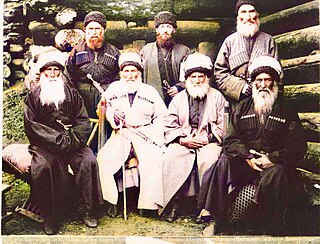
The Karachays or Karachai are an indigenous North Caucasian-Turkic ethnic group native to the North Caucasus. They are primarily located in their ancestral lands in Karachay–Cherkess Republic, a republic of Russia in the North Caucasus. They have a common origin, culture, and language with the Balkars.

Non-Germans in the German armed forces during World War II were volunteers, conscripts and those otherwise induced to join who served in Nazi Germany's armed forces during World War II. In German war-time propaganda those who volunteered for service were referred to as Freiwillige ("volunteers"). At the same time, many non-Germans in the German armed forces were conscripts or recruited from prisoner-of-war camps.
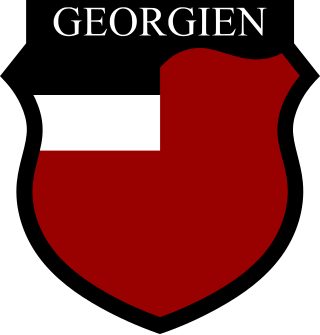
The Georgian Legion was a military formation of Nazi Germany during World War II, composed of ethnic Georgians. It was formed by Georgian émigrés and prisoners of war; its declared aim was the eventual restoration of Georgia's independence from the Soviet Union under Nazi Party's doctrine and supervision. Some components of the Georgian Legion fell under the operational control of Waffen-SS.
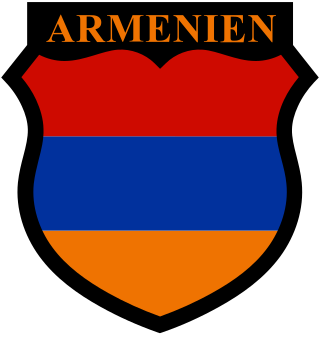
The Armenian Legion was a military unit in the German Army during World War II. It primarily consisted of Soviet Armenians, who wanted to fight the Soviets for an independent Armenia and commanded by General Drastamat Kanayan.
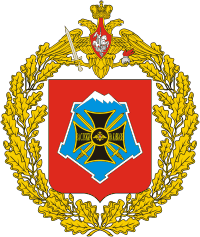
The North Caucasus Military District was a military district of the Russian Armed Forces from 1992-2010. Before 1992 it had been part of the Soviet Armed Forces since 1918. In 2010 it became the Southern Military District and lately also included the Black Sea Fleet and Caspian Flotilla.
The 76th Rifle Division was a Red Army infantry division, formed twice.
The 1940–1944 insurgency in Chechnya was an autonomous revolt against the Soviet authorities in the Chechen-Ingush Autonomous Soviet Socialist Republic. Beginning in early 1940 under Hasan Israilov, it peaked in 1942 during the German invasion of North Caucasus and ended in the beginning of 1944 with the wholesale concentration and deportation of the Vainakh peoples from their native lands as well as from the locations across the USSR, resulting in the death of at least 144,000 civilians. However, scattered resistance in the mountains continued for years.

The Azerbaijani Legion was one of the foreign units of the Wehrmacht. It was formed in December 1941 on the Eastern Front as the Kaukasische-Mohammedanische Legion and was re-designated 1942 into two separate legions, the North Caucasian legion and the Azerbaijani legion. It was made up mainly of former Azerbaijani POW volunteers but also volunteers from other peoples in the area. It was part of the Ostlegionen. It was used to form the 162nd (Turkistan) Infanterie-Division of the Wehrmacht in 1943. similar to other Ostlegionen, it was organised to replenish the dwindling German manpower on the Eastern front and to "save the German blood at the front"
The 131st Separate Motor Rifle Brigade was a motorised infantry unit of the Soviet Army and of the Russian Ground Forces.

The Caucasian-Mohammedan Legion was a volunteer unit of the German Army during World War II. The Legion was created on 13 January 1942 by order of General of the Infantry Friedrich Olbricht. The Legion consisted of Abkhazians, Circassians, Balkars, Karachays, Chechens, Ingushes, and the peoples of Daghestan. The Kurds, Talyshis and Ossetians appeared later. In accordance with the decree of 19 February 1942, volunteers from the peoples of the North Caucasus were on 2 August 1942 allocated on a national-territorial basis separately to the North Caucasian Legion / Mountain-Caucasian Legion. The initial placement of the Legion was Wesel.

The military history of Azerbaijan is framed within thousands of years of armed actions of many other states in the territory encompassing modern Azerbaijan, as well as the shorter history of interventions by the Azerbaijani Armed Forces in conflicts abroad. The Azerbaijanis are the inheritors of the lands of various ancient civilizations and peoples including the indigenous Caucasian Albanians, Iranian tribes such as Scythians and Alans, and Oghuz Turks among others.

The insurgency in the North Caucasus was a low-level armed conflict between Russia and militants associated with the Caucasus Emirate and, from June 2015, the Islamic State, in the North Caucasus. It followed the official end of the decade-long Second Chechen War on 16 April 2009. It attracted volunteers from the MENA region, Western Europe, and Central Asia. The Russian legislation considers the Second Chechen War and the insurgency described in this article as the same "counter-terrorist operations on the territory of the North Caucasus region".
The Separate Coastal Army, also translated to English as Independent Coastal Army, was an army-level unit in the Red Army that fought in World War II. It was established on July 18, 1941, by the order of the Southern Front from the forces of 9th Army’s Coastal Group and was stood up on July 20, 1941.
The Special Group Bergmann or the Bergmann Battalion was a military unit of the German Abwehr during World War II, composed of five German-officered companies of the Caucasian volunteers.
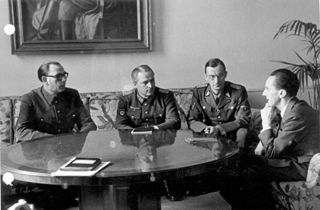
Among the approximately one million foreign volunteers and conscripts who served in the Wehrmacht during World War II were ethnic Belgians, Czechs, Dutch, Finns, Danes, French, Hungarians, Norwegians, Poles, Portuguese, Swedes, Swiss along with people from Great Britain, Ireland, Estonia, Latvia, Lithuania, and the Balkans. At least 47,000 Spaniards served in the Blue Division.
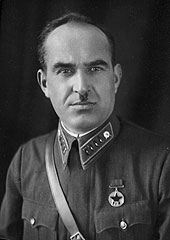
Ivan Ilyich Lyudnikov, was a Soviet Army Colonel General and Hero of the Soviet Union.
The 295th Rifle Division was an infantry division of the Soviet Union's Red Army and later the Soviet Army, formed twice.
The 406th Rifle Division was raised in 1941 as an infantry division of the Red Army, and served throughout the Second World War in that role, but saw relatively little combat. It was raised as a Georgian National division in the Transcaucasus Military District, where it remained until the forces of German Army Group A began its drive on the oil fields there as part of Operation Blue. In August 1942 it joined the Northern Group in the Transcaucasus Front, in the 46th Army, defending the high passes through the High Caucasus Mountains west of Mount Elbrus. Once the German threat receded, the 406th returned to guard duties along the borders with Turkey and Iran for the duration of the war.
The 414th Rifle Division was twice formed as an infantry division of the Red Army; very briefly in the winter of 1941/42, then from the spring of 1942 until after May 1945. It was officially considered a Georgian National division, having nearly all its personnel of that nationality in its second formation. After its second formation it remained in service in the Caucasus near the borders of Turkey and Iran in the 44th Army until the summer of 1942, when it was redeployed to help counter the German drive toward Grozny. As German Army Group A retreated from the Caucasus in January 1943 the division was reassigned to the 37th Army in North Caucasus Front, and during the fighting in the Taman Peninsula during the summer it served in both the 58th and 18th Armies, earning a battle honor in the process. It entered the Crimea during the Kerch–Eltigen Operation in November, and was awarded the Order of the Red Banner following the offensive that liberated that region in April and May 1944, fighting in the 11th Guards Rifle Corps of the Separate Coastal Army. After the Crimea was cleared the Coastal Army remained as a garrison and the 414th stayed there for the duration of the war. Postwar, it was relocated to Tbilisi, being renumbered as the 74th Rifle Division in 1955 and disbanded the following year.

The Mountainous Republic of the Northern Caucasus, an unrecognized state created during the Russian Civil War that existed from 1917 to 1922, used two flags as its symbols. One of them consisted of seven green and white stripes and a blue canton with seven yellow stars, in its top left corner. The other featured a green canton with a yellow or white crescent and seven stars, placed in the top left corner, on the red background.













